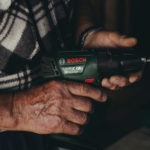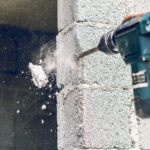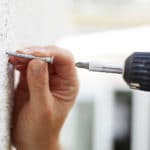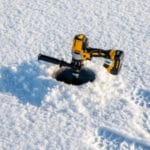Both impact drivers and impact wrenches are designed to provide power to fasten or loosen bolts and screws. They both use an impact mechanism to achieve this.
Basically, an impact wrench is a must for larger projects. It has more torque and can handle heavier-duty fastening tasks. Impact drivers are smaller, lighter, and less expensive than impact wrenches.
But what’s the difference? And which one is right for the job? Should you use an impact wrench or impact driver?
Let’s dive in and take a closer look.
What is an Impact Driver?
An impact driver is a power tool that, in its most basic form, has the same operating mechanism as a hammer drill. It delivers rotary power through a sliding (or ‘hammer’) action instead of a rotating action.
The hammer action is created by using a mass (the ‘hammer’) to hit a percussive follower (the ‘anvil’). This force is then transferred into the drill bit, which turns along a degree of freedom perpendicular to the drill shaft, and into the workpiece.
An impact driver is a tool that delivers a rotary impact to the fastener. It is driven by a motor and has a hammer that strikes an anvil to create a rotary impact. These tools feature a 1/4 inch quick-change hex drive and high torque.
Industry standards allow for a maximum torque of 1100 in-lbs from an impact wrench.
The main advantage of an impact driver is that it does not require as much effort to drive the fastener into the material.
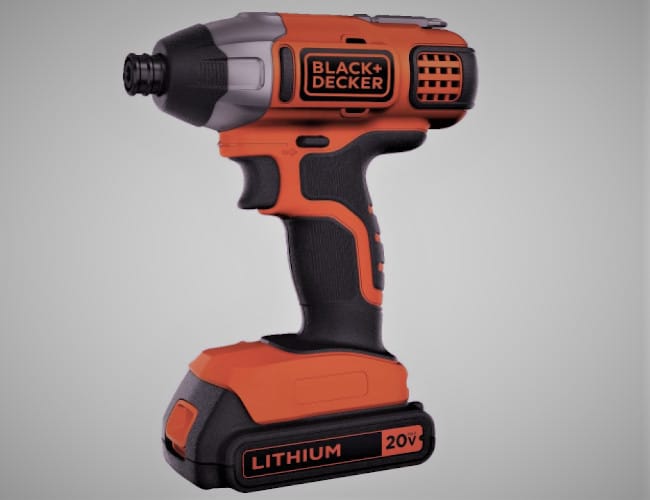
There are two main types of impact drivers:
Cordless Impact Drivers
A cordless impact driver typically has a higher torque than cordless drills and provides power to fasten or loosen bolts and screws. There are three types of cordless impacts drivers:
- Rotary Impact: The hammer rotates independently from the motor shaft. This type is most common in low-cost tools.
- Linear Impact: The hammer moves in a straight line and is common in high-end tools.
- Sidewall Impact: The hammer moves in a circle and is common for fastening screws into metal.
Corded Impact Drivers
Corded impact drivers are available in both pistol-grip and inline designs. The hammer is attached to the motor shaft, which delivers rotary impact to the fastener.
Specifications of Impact Drivers
The following are the specifications of impact drivers:
| Specifications | Output |
|---|---|
| Voltage | 18 to 36 volts |
| Bit Holder | 6.35 mm |
| Chuck Size | 1/4 inch hex |
| Torque | 250 Nm |
| Power Output | 400 Watt |
| Weight | 1.34 kg |
What are Impact Drivers Used For?
An impact driver is commonly used for screwing into difficult applications where a regular drill or driver will not suffice. They are capable of producing much more torque than regular drills, so they can be used to easily drive screws into hard materials such as metal, bricks, or concrete.
Industrial impact drivers are designed to be used continuously for many hours. Their size and power allow them to drive screws into hard-to-reach areas that a regular drill can’t.
An impact driver is a power tool that uses a hammering motion to drive screws into hard materials. Impact drivers produce a high amount of torque and are used in industrial settings for production line work.
When shopping for impact drivers, it’s important to know the difference between the cordless and corded varieties. The primary advantage of an impact driver is its high torque capability, which means it can drive screws into hard materials such as metal, bricks, or concrete.
The following are the common uses for impact drivers:
This table simplifies the common uses of impact drivers so you decide if that’s what you are looking for.
| Uses | Result |
|---|---|
| Driving Screws into Hard Materials | It is difficult to drive screws into hard materials like metal, concrete, and masonry with a standard drill or screwdriver. An impact driver, with its high torque, can easily do the job. |
| Driving Screws into Soft Materials | A standard drill or screwdriver may damage screws when driving them into soft materials like drywall or wood. An impact driver’s high torque helps ensure proper penetration without damaging the material around the screw-head. |
| Driving Screws into Hard to Reach Places | Impact drivers are capable of driving screws into very hard-to-reach places. Some impact drivers come with a long drill bit that can help you reach screws in tight spots. |
| Removing Stripped Screws | If a screw has been stripped, it can be difficult to remove it with a standard drill or screwdriver. An impact driver’s hammering action can help loosen the stripped screw. |
| Driving Anchors | Impact drivers can be used to drive anchors into masonry or concrete. The high torque helps the anchor set properly and prevents it from slipping out. |
| Drilling Holes | Impact drivers can be used to drill holes in soft materials like drywall, plastic, and wood. The high torque helps the drill bit drill through the material quickly and efficiently. |
| Using Extensions | Most impact drivers accept 1/4 inch hex drive attachments, allowing you to use extensions for additional reach or to access screws that are deeper in a material. |
Industrial impact drivers are designed for heavy-duty use by production line workers. Impact drivers are available in both cordless and corded varieties. The primary advantage of an impact driver is its high torque capability, which means it can drive screws into hard materials such as metal, bricks, or concrete.
So, now you have everything about impact drivers. Let’s talk about the main insights about impact wrench.
What is an Impact Wrench?
An impact wrench is a power tool that uses a hammering motion to drive screws into hard materials. Impact wrenches produce a high amount of torque and are used in industrial settings for production line work.
It is used to apply large amounts of torque to a nut or bolt. It provides a twisting force, or torque, to turn the fastener. Impact wrenches are powered by compressed air, an electric motor, or a hydraulic motor.
When shopping for impact wrenches, it’s important to know the difference between the cordless and corded varieties. The primary advantage of an impact wrench is its high torque capability, which means it can drive screws into hard materials such as metal, bricks, or concrete.
They are commonly used in automotive garages and repair shops.

Specifications of an Impact Wrench
The following are the specifications of impact drivers:
| Specifications | Output |
|---|---|
| Amount of torque | 30 ft-lbs |
| Amount of torque generated | 200 ft-lbs |
| Maximum RPM | 3000 |
| Air consumption | 7 CFM (cubic feet per minute) |
| Maximum air pressure | 135 psi (pounds per square inch) |
| Maximum noise level | 100 dBa (decibels on the A scale). |
A homeowner may use an impact wrench for a number of tasks, including:
- Loosening corroded or frozen nuts and bolts
- Tightening lug nuts on a car or truck
- Installing or removing screws on large appliances
- Operating a jack to raise a vehicle
- Inflating tires on cars, bikes and trucks
- Drilling into concrete or metal
- Grinding metal surfaces
- Polishing metal surfaces.
Usually, impact wrenches are available in two types: Pneumatic and Electric.
- Pneumatic Impact Wrenches: These wrenches use high-pressure air to power the wrench, and they are often used by road service crews to remove lug nuts from vehicle wheels.

- Electric Impact Wrenches: These wrenches use electricity and can be cordless or corded. They come in a variety of sizes and shapes that can accommodate different types of fasteners.
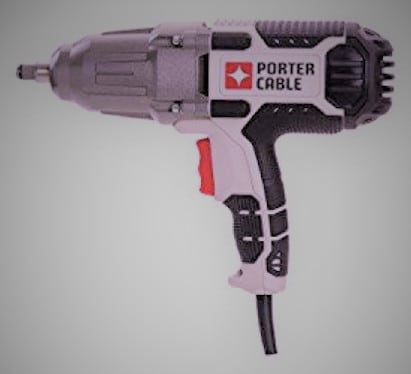
Why People Prefer Impact Wrench?
- Power: An impact wrench uses the rotating force of fast-moving components to break loose stubborn nuts and bolts.
- Versatility: Impact wrenches can be used for a variety of tasks, such as automotive work, construction projects, plumbing, and other repair or assembly jobs.
- Ease of use: These wrenches are easier to handle and have better control than standard wrenches.
- Speed: The rotating force applied by this wrench is much faster compared to common hand tools. The user can rely on an impact wrench for all his tightening or loosening needs, both indoors and outdoors.
What are Impact Wrenches Used For?
There are a number of reasons why you might need an impact wrench. If you’re a homeowner, there are some specific tasks you can use it for, like loosening corroded or frozen nuts and bolts, tightening lug nuts on a car or truck, installing or removing screws on large appliances, or operating a jack to raise a vehicle.
The following are the most common uses of impact wrench:
| Uses | Result |
|---|---|
| Loosening Tight or Rusty Nuts and Bolts | Over time, nuts and bolts can become very tight and difficult to loosen. An impact wrench can quickly break them loose. |
| Removing Damaged Lug Nuts | Lug nuts that are damaged or rusted can be very difficult to remove without the help of an impact wrench. |
| Removing or Installing Tires | An impact wrench works particularly well when removing and installing tires. It makes the job go by quickly. |
| Grinding Metal Surfaces | This tool can be used to grind metal surfaces, such as concrete or metal, in order to smooth them out. |
| Operating a Jack | Impact wrenches can be very helpful when operating a jack. They provide the necessary force to quickly raise a car or truck. |
| Drilling into Concrete or Metal | Impact wrenches are perfect for drilling into concrete or metal surfaces. |
| Inflating Tires | Impact wrenches can also be used to inflate tires, making it easier to get your car or bike ready for the road. |
| Polishing Metal Surfaces | The rotating force applied by this wrench is also useful for polishing metal surfaces. |
Now you know everything about Impact drivers and Impact wrench, and common uses. Let’s talk about the difference between impact drivers and impact wrench:
Differences Between Impact Driver and Impact Wrench
- Power: An impact wrench is more powerful than an impact driver. It is able to generate up to 1,200 pounds per square inch of torque.
It is not as powerful as a breaker bar but is more powerful than an electric drill. An impact driver produces around 500 pounds per square inch of torque and is not as effective in removing tight or damaged lug nuts. - Size and Weight: An impact wrench is larger and heavier than an impact driver and is not as easily portable. Impact drivers are smaller and lighter than impact wrenches and can easily be used in small spaces.
- Speed: Impact drivers are able to apply more torque faster than impact wrenches. This is due to their smaller size and lighter weight. Also, they are lighter in weight, so the user doesn’t have to exert as much force in order for them to operate.
- Operation: Impact drivers are powered by electricity and can be used with a battery or plugged into an outlet. Impact wrenches are powered by air and must be connected to an air compressor.
- Applicability: Both impact drivers and impact wrenches can be used for many tasks. However, the impact wrench is made specifically for loosening or tightening nuts and bolts.
- Price: Impact wrenches are more expensive than impact drivers. However, the price difference is worth it, as the impact wrench can do more than the impact driver.
- Drive Style: Impact drivers use a 1/4-inch hex-style drive, while impact wrenches use a square drive. Basically, the square drive is a more universal fit and can be used with other tools, while the hex-style drive is specific to impact drivers.
If you aren’t clear about the difference between both, this easy explainer video will surely clear all the differences.
There you have it! The difference between impact drivers and impact wrenches. But the point is, which is the best Impact driver or impact wrench for your needs?
Frequently Asked Questions
Which is Better Impact Driver or Impact Wrench?
This is a difficult question to answer as it depends on the user’s specific needs. An impact wrench is more powerful and can be used for heavier-duty tasks, such as removing lug nuts.
An impact driver is smaller and more portable, making it perfect for light-duty tasks, such as putting together furniture.
These tools are great, so it comes down to personal preference. Just do a little research, and you’ll soon know which tool will work best for your specific needs.
The best way to decide which tool is better for you is by understanding the differences listed above. You can then use this knowledge to match your needs with the features of one or both tools.
For example, if you need a portable tool that can easily be used in tight spaces, an impact driver would be a better choice than an impact wrench. If you need a more powerful tool that can generate more torque, then an impact wrench would be the better option.
Can an Impact Driver Be Used as an Impact Wrench?
Yes, an impact driver can be used as an impact wrench. This can allow you to save money by purchasing just one tool that will serve a dual purpose.
Is it Worth Getting an Impact Wrench?
Yes, it is worth getting an impact wrench. Impact wrenches are more powerful and can be used to remove lug nuts from a vehicle, for example. If you need a more powerful tool that can generate more torque, then an impact wrench would be the better option.
How Does an Impact Driver Differ From a Screwdriver?
There are many differences between an impact driver and a screwdriver. An impact driver is equipped with an electric motor that helps it generate higher torque, while a screwdriver relies on manual power.
An impact driver also uses a hex-style drive, while a screwdriver uses a Phillips or flat head screw.
Are Impact Drivers Suitable for Drilling Holes in Brick/Concrete?
No, impact drivers are not suitable for this type of task. Impact drivers are designed to tighten and loosen screws and bolts, not drill holes.
Can an Impact Driver Be Used to Drill a Hole in a Drywall?
Yes, an impact driver can be used to drill a hole in drywall. Many impact drivers come with screwdriver bits that can be used to drill holes.
What is the Best Impact Wrench for Occasional Use on Cars?
A cordless 1/4″ impact wrench might be the best option for occasional use on cars. A cordless impact wrench is more convenient as it does not need to be plugged into a power source.
How Do I Adjust the Torque on an Air Impact Wrench?
Adjusting the torque on an air impact wrench is a straightforward process. First, determine which setting you need for your project by reading the information provided with the product.
For example, lower torque settings are usually used for light duty tasks, while higher torque settings are suitable for heavy-duty projects. Once you have selected your desired torque, switch the setting to the appropriate option.
Will an Impact Wrench Break Bolts?
Yes, an impact wrench can break bolts. However, most impact wrenches are equipped with a mechanism that prevents it from breaking bolts in most circumstances.
Can I Use an Impact Wrench to Remove Lug Nuts?
Yes, an impact wrench can be used to remove lug nuts. An impact wrench is more powerful and can generate greater torque than a regular wrench.
Is it OK to Use an Impact Wrench on a Stuck Oil Drain Bolt?
Yes, using an impact wrench on a stuck oil drain bolt is okay. However, be sure that the impact wrench is securely fastened to the drain bolt to avoid accidents.
Conclusion
So, whether you are looking for the best impact wrench or the best impact driver, knowing their differences will enable you to choose between them easily.
The main difference between an impact driver and an impact wrench is its size, power, torque, usage, and price. The bigger the tool, the more powerful it is. But the smaller the tool is, the lighter it is.
An impact driver can generate up to 500 lbs/sq in, while an impact wrench can generate up to 1200 lbs/sq in. Both of these tools are made for different purposes, where the impact driver is made for light duty.

